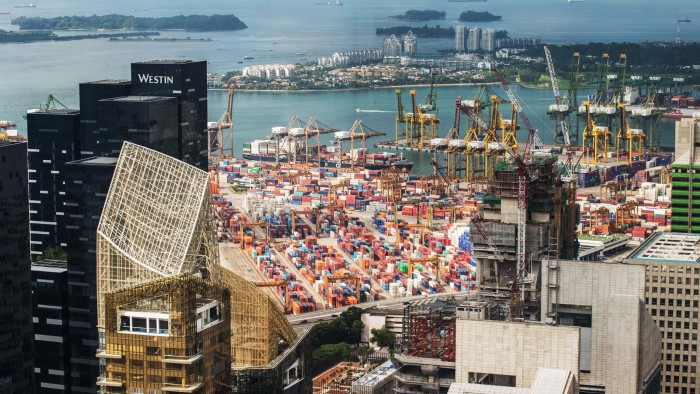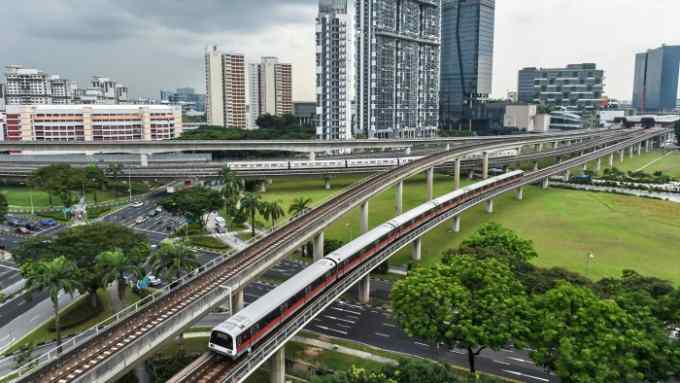Global strategy underpins Singapore’s foreign investment growth

Roula Khalaf, Editor of the FT, selects her favourite stories in this weekly newsletter.
For an island nation spread over just 700 sq km, Singapore wields outsized economic clout. The city state has grown inordinately wealthy since its 1965 separation from neighbouring Malaysia, recording gross domestic product per capita of nearly six times that of its former partner to the north.
Such wealth has been driven in part by Singapore’s transformation from a sleepy trading post into a modern centre for global finance.
As the economy developed, however, it soon became clear that a tiny domestic market presented limits to growth, while Singapore’s position at the heart of Asian trade offered it the ideal location to seek opportunities abroad.
“It is critical for Singapore companies, especially small and medium-sized enterprises, to internationalise, given our small domestic market,” says Kathy Lai, deputy chief executive of Enterprise Singapore, a government agency that supports business growth and foreign investment.
“Many companies already recognise internationalisation as a necessary strategy for continued growth.”
The strategy of looking outward, pioneered from the 1990s and actively encouraged by the government, has borne fruit. Singapore’s total direct investments abroad have risen from S$672bn ($496bn) in 2011 to S$850bn in 2017, with more than 50 per cent of that concentrated in Asia, according to the Singapore Department of Statistics (Singstat).
Greenfield flows, which track new investment, show that foreign investment out of Singapore hit its highest figure yet in 2018, totalling $28.9bn, according to fDi Markets, an FT-owned database of cross-border investment. This represented a doubling from 2017.
China receives the lion’s share from the Lion City, garnering more than $80bn in greenfield investment from Singapore since 2003. Other top greenfield investment destinations include India, which has received $27bn from Singapore, Vietnam with $22bn, Indonesia $19bn and Malaysia $10bn.
Trends in fast-growing neighbours continue to support these outflows, with infrastructure projects, strong consumer demand from young populations and emerging digital economies among the drivers, according to Ms Lai.
“Asian countries are investing and building up their connectivity infrastructure, in turn lowering barriers to internationalisation,” she says.
Overseas investment by Singapore companies — which previously have focused on property, oil and gas, tourism and financial services — has broadened more recently to include communications and chemicals.
Government-linked companies have been among the foremost Singapore groups pushing into new markets. GLP, part-owned by sovereign wealth fund GIC, was one of the biggest investors in property out of Singapore in 2018, according to fDi Markets, investing in projects across Europe.
ST Telemedia (STT) is another case in point. An investor in media and communications, with revenues of S$3.9bn in 2018, the company comes under the umbrella of Temasek, another Singaporean sovereign wealth fund. Since the beginning of 2019, Temasek has invested $995m in new construction projects in India, Indonesia and Thailand. Last year, STT invested $227.5m in a Bangkok data centre, due to open in 2020. Stephen Miller, group president and chief executive, says China, India and the UK are all important markets for STT.
“Despite the current economic and geopolitical volatility, [we] see sustained growth in countries where there is a strong government digitalisation push supported by consistent . . . policies to facilitate the rollout of digital infrastructure,” he says.
State-linked companies are not the only big investors, however. Last year conglomerate Next Story Group put $180m into a city centre development in Colombo, while Keppel Puravankara Development, a Singapore-India joint venture, invested $286m in an office tower development in Bangalore.
The Asian financial crisis of the late 1990s prompted the Singapore government to promote a policy of “regionalisation” that encourages companies to look beyond Asia-Pacific to markets in Europe, Latin America and emerging Asia.
The goal, according to the ministry of trade and industry, is to “diversify risks from economic shocks in any one region”.
“We stepped out into Asia in 2002, investing beyond Singapore into markets such as China and India. We also started to identify early opportunities in Brazil and Mexico, establishing offices in São Paulo and Mexico City about a decade ago,” says Temasek, which over the past few years opened offices in New York, London, Washington DC and San Francisco.
That international spread might prove a prudent decision: China’s economy is slowing, annual growth in Asia-Pacific is forecast to drop below 6 per cent for the first time since the Asian financial crisis, and the US-China trade war is causing ripples across the region.
However, with much of Singapore’s overseas investment centred in China, portfolios might start to feel one-dimensional. China’s real estate market — a favourite sector for Singaporean investment — has slowed in 2019, as prices plateau in big cities and government regulations tighten.
Still, long-term investors believe they can weather slower growth. “We have been closely watching the global macroeconomic environment and how certain events might have an impact on our portfolio,” Temasek says. “But as a long-term investor, we can ride out short-term market volatility.”

Comments